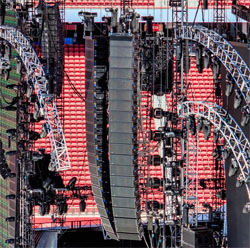
Large-format line arrays (which we loosely identify as models with 12-inch and larger woofers) are ideal for large-scale concert and event applications, both indoors and outdoors. They really deliver in terms of output, and in many cases, are now much more than simply loudspeakers, better described as fully integrated systems.
The vast majority of the models we’re presenting here incorporate dedicated power and DSP packages (onboard or rack mounted), as well as being outfitted with increasingly sophisticated control, networking, and optimization packages. Integral rigging is user-friendly and marked by precision and ease of use; in some cases, a single person can erect large-scale arrays relatively quickly.
Driver configuration and enclosure design remains a defining factor. Some employ dual woofers with a center high-frequency section to provide horizontal symmetry. The simplest systems may just have a single cone and high-frequency driver.
Quasi 3-way solutions use dual woofers, but low-pass one woofer at a lower frequency than the other, thereby eliminating cancellations at higher frequencies where their acoustic centers are farther apart than the wavelengths being reproduced.
True 3-way designs operate separate low-, mid- and high-frequency drivers, each in their own band. There are several approaches to horn-loading, which can provide higher sensitivity for additional power. And now, we’re seeing some 4-way systems, with the mid-frequencies subdivided into two sections.
In the listings of recently introduced products here, note that the horizontal dispersion spec is provided for all models. Vertical dispersion varies, and in most cases is dependant on array structure and configuration.
Also, several companies offer more than one choice in this category, and for the most part, we’ve selected the largest model and/or the most recently introduced model, with the other options referenced.
Most line arrays also have companion subwoofers to provide low-frequency extension, and many of these fit within flying array structures. Many manufacturers also offer complementary array elements with larger angles of coverage that perform better as the lowest near-throw enclosure in a vertical array.
Be sure to take our Real World Gear Tour of the latest large-format line arrays from around the industry.
